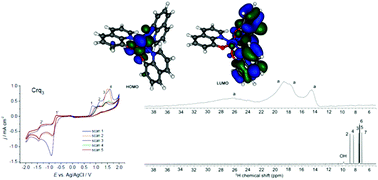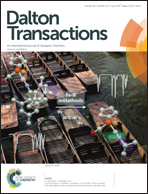Synthesis, structure, and spectral and electrochemical properties of chromium(iii) tris-(8-hydroxyquinolinate)†
Abstract
The kinetically inert chromium(III) tris-(8-hydroxyquinolinate), Crq3, has been synthesized, crystallized from 90% methanol–water, and characterized by MALDI-TOF mass spectrometry, thermogravimetry, FTIR, NMR spectroscopy, and X-ray powder diffraction. It is formed as a methanol solvate, but the solvent can be removed by heating. Large paramagnetic shifts and spectral broadening in 1H NMR spectra indicate electron delocalization between the metal and the ligand. DFT calculations show it is present as the meridional isomer, with the HOMO largely based on one of the metal 3d orbitals and the LUMO essentially localized on the ligands. Cyclic voltammetry (CV) in acetonitrile solutions shows four oxidation peaks and two, less intense reduction waves on the first scan. The HOMO energy determined from the first oxidation peak is fairly close to that obtained by DFT, in agreement with this being mainly metal based. Although the number of peaks decreases on subsequent CV scans, the complex shows markedly enhanced electrochemical stability compared with aluminium(III) tris-(8-hydroxyquinolinate). Solution UV/visible absorption and solid diffuse reflectance spectra have a weak, long wavelength band, assigned to the metal based d–d transition, in addition to the normal, ligand based bands seen in metal quinolates. The energy of the lowest energy band is identical to the HOMO–LUMO separation obtained by cyclic voltammetry, in agreement with the above description. The compound is only weakly luminescent, in contrast to many other metal quinolates, due to the lowest energy transition being metal rather than ligand based. The potential of this compound as an electron transporting/hole blocking layer in optoelectronic devices is indicated.


 Please wait while we load your content...
Please wait while we load your content...